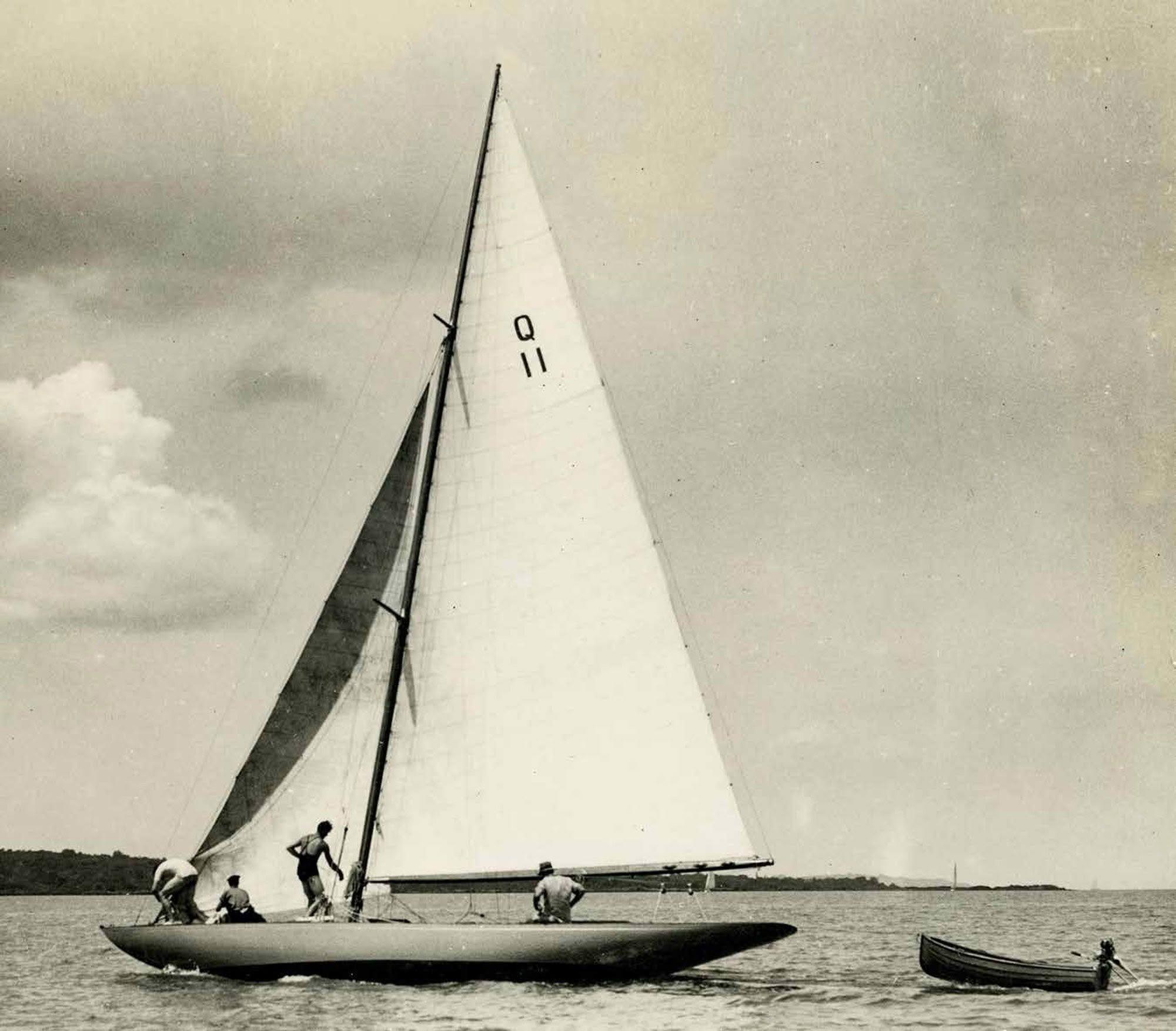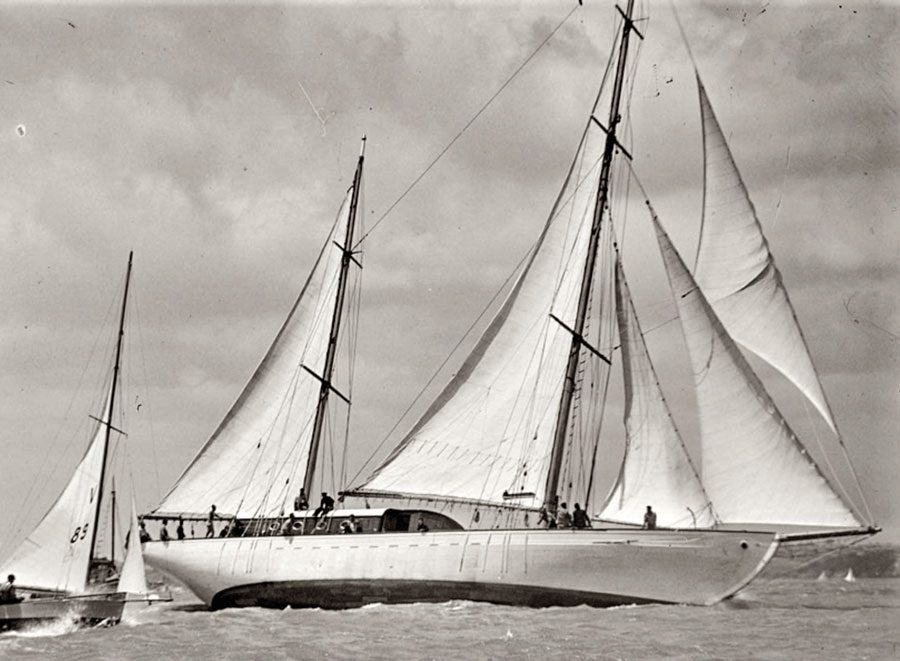

Harry Jenkins could trace his ancestry through his mother’s side back to Sir Francis Drake. His new yacht, Golden Hind, the biggest private yacht yet built in New Zealand, echoed that pedigree.
The British Board of Trade however, would not allow the registration under that name, because there was another Golden Hind on the Register already. So, when completing the fitting out in Auckland, Baileys painted the word ‘New’ above the name on her counter, in a rather smaller font than ‘Golden Hind’. Harry offered her to the New Zealand Government, but it could see no use for her then; she became very useful later.
Although the outbreak of war with Germany in September 1939 forced Harry to abandon his planned voyage to England, he pressed ahead with a Pacific cruise, unaware that the German commerce raiders Komet and Orion were soon to be active in the Pacific, sinking ships and laying mines.
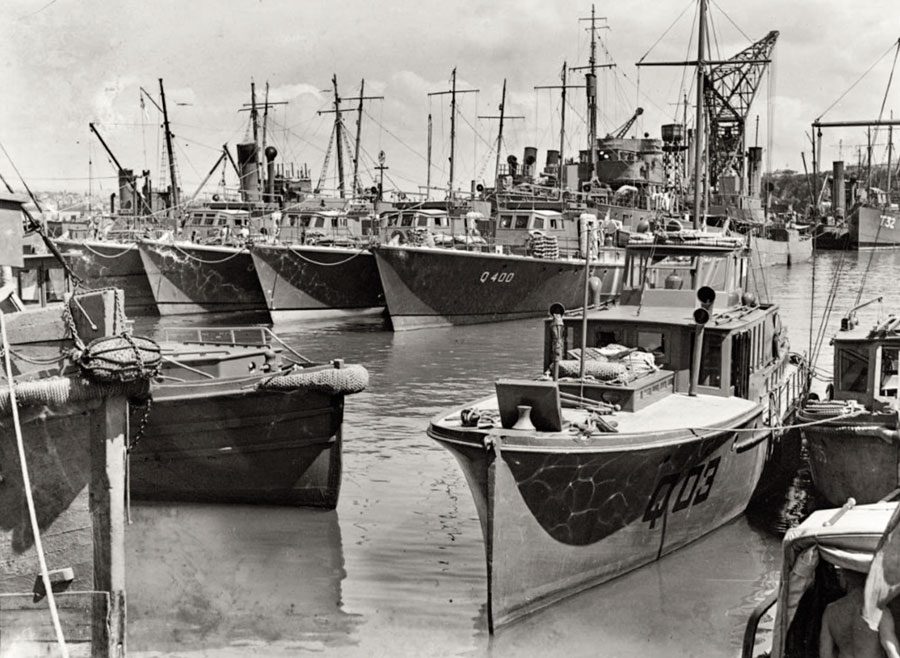
New Golden Hind left Auckland on her maiden Pacific cruise on October 18, 1939 under the command of Capt. John Benton, former skipper of the Bailey-built A.B. Donald schooner Tiare Taporo, Capt. F.W. Wainhouse, mate, Harry learning the ropes, and 11 passengers including some local yachtsmen. She arrived in Suva after a smart passage of eight days despite head-winds requiring assistance from her Kelvin diesel. Harry formally registered her in Suva as a British Registered Ship. The yacht then visited Samoa and Tonga, returning from Nuku’alofa after a 6,000-mile voyage on December 22, 1939.
After a spell in the Bay of Islands, Harry brought her back to Auckland for a cameo appearance in the 1940 Anniversary Regatta. In February she was off to Doubtless Bay with Gilbert Archey of the Auckland War Memorial Museum recovering moa bones from the sandhills, the first of many such scientific expeditions in which she was to become involved.
But the Pacific still called, and Harry set off on his second cruise, intended to be for three months, on May 4, 1940, with several passengers and crew. Harry said “we are just going to meander round the Pacific”. The 18 passengers and crew paid £4/10/- ($9) a week each. In hindsight, this all seems rather strange with the Dunkirk evacuation and the Battle of Britain only days in the future and when most New Zealand yachtsmen were hauling their boats out ‘for the duration’ and signing up for military service.
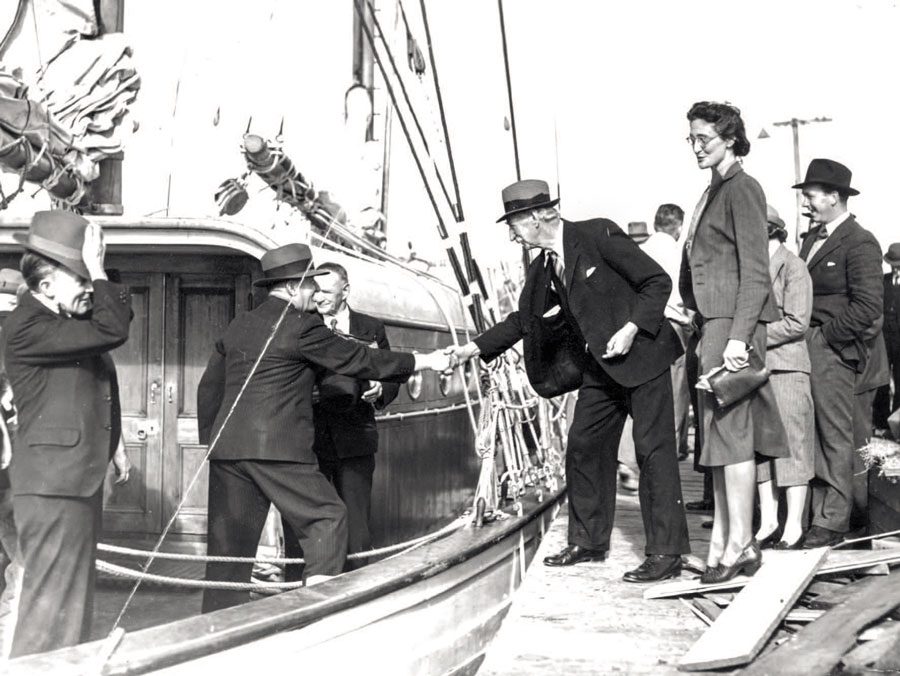
The first call was at Sunday Island (Raoul) in the Kermadecs to pick up Bruce Robertson as crew and then on to Nuku’alofa.
The yacht must have come close to the German raider Orion which, on the night of June 13–14, 1940, laid 228 contact mines off Bream Head. The Canadian-Pacific steamer Niagara struck two mines on the morning of the 19th , in calm weather, and sank quickly by the bows. To assist Britain, she carried most of the country’s gold reserves, donated small arms (including my father’s cherished Lee-Speed .303) and ammunition together with 348 passengers and crew, all of whom survived.
From Raoul, New Golden Hind visited Vava’u and other islands in the Tongan group, carrying large quantities of farepaying passengers between islands. The mining of the Niagara and the evidence of German commerce raiders, or possibly submarines, must have given Harry pause for thought. But New Golden Hind carried on to Suva in July and to Pago Pago and Apia until the cruise had to be abandoned in December 1940 as the war news went from bad to worse.
With a crew of two Tongan sailors and Peter Thompsen as navigator, he sailed New Golden Hind from Apia to Honolulu in an unsuccessful effort to sell her there. Returning via Tahiti, he negotiated the release of one of the anchors from the Bounty and brought it back with him on New Golden Hind to present to the Auckland Museum. He offered New Golden Hind to the New Zealand Government again but, again, she was unwanted.

Harry was now 59 and under an official cloud. New Golden Hind’s Pacific cruises were thought to be reckless and selfindulgent during wartime and there was a suggestion that he had “stirred trouble in Tonga”. They were strange times; Harry was forbidden to take his yacht offshore again.
In fact, the Government’s Naval Board had been secretly setting up coast-watching stations around New Zealand’s southern island groups, the Kermadecs and, later, when the threat of Japanese invasion became intense, the Pacific Island groups. The first vessels requisitioned to service these stations were the strong Stewart Island-built ketch Ranui and the Cook Islands’ trader Tagua, both run ostensibly by the Public Works Department. New Golden Hind joined them in April 1942. Her luxurious fittings were stripped out and a hatchway and hold cut into her hull. A second Kelvin diesel was fitted.
Under the command of Capt. A. Cole and armed with two Bren guns, two Lewis guns and eight rifles, she was sent to the Ellice Islands [Tuvalu], frequently under observation by Japanese aircraft, to service the coast-watchers. She returned to Suva to join Ranui and Tagua on less hazardous supply missions throughout the rest of the war.
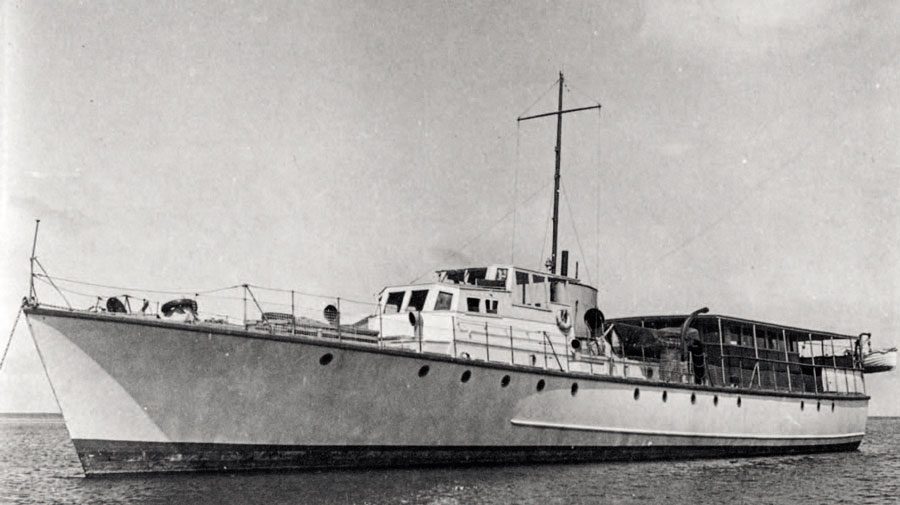
After the war, the PWD retained New Golden Hind and she was kept busy for several years, for example, a mercy trip to Pitcairn Island, taking a party of scientists to the West Coast Sounds searching for uranium, goat hunting parties to the Three Kings and Raoul, and to New Caledonia and Guadacanal to retrieve Army personnel and RNZAF war materiel in the wind up of the bases there.
In December 1947 it was discovered New Golden Hind had dry rot in her starboard triple diagonal planking. The Naval Dockyard at Devonport repaired her. After a routine voyage to the Kermadecs in June 1949 she was laid up at Auckland. Her current role servicing our remote Pacific radio and meteorological stations was then taken over by the Navy. In October 1949 she was put out to tender by the Government Stores Board. Two months later it was announced that she had been sold to a syndicate of E Sheehan of Whangarei, Athol Rusden and R. Baker of Auckland, and sailed up to Whangarei and on to the Pacific.
In 1952 New Golden Hind was sold to Hervé and Co of Tahiti for use as a trader around French Polynesia. They renamed her Artemise. In February 1953 it was reported that she had been totally destroyed by fire at Raroia, in the Tuamotus. She was insured for 3,500,000 francs, about £16,000 in 1952 money.

Returning to Harry Jenkins, his Shenandoah, then owned by Fred Chamberlin of Ponui Island, was taken over as a patrol launch by the Navy in August 1940 as Q03 for ‘outer patrol’, based at Russell and Whangarei. The Navy paid her off in March 1945 and sold her back to Chamberlin in September 1945. Subsequently she was used in the mussel trade but has recently reverted to pleasure use and is moored in Parua Bay in good shape.
Harry Jenkins had one more round with fine boats left in him. His wife Dot died in 1943. When the War Assets Realisation Board started disposing of the RNZN’s Fairmile patrol launches in late 1946, Harry, then living at Arkle’s Bay, was the first to buy one, for £1,255. It was Fairmile ML401 built in Auckland in 1943 by Charles Bailey & Son Ltd for £35,000. She was a veteran of Guadalcanal anti-submarine screen patrols out of Renard Sound. The twin 575hp V12 Hall-Scott Defender petrol engines were lifted out. Harry gave them to the engineer who removed them, and replaced them with 165hp GM diesels.
Harry renamed her Mahurangi. In typical style, he told the press that he had bought her “for wintering in the Pacific.” His real intention was to take her to Fiji and use her for inter-island passenger work. He took great pleasure in supervising the conversion. In Suva she was certified to carry 44 passengers, but, apart from an occasional charter, the work was not there. She lay at anchor for many months until Harry gave the project away at the end of 1947 and returned to New Zealand, leasing Mahurangi to local traders. In 1949 he sold her to Cook Islands owners, she eventually sank in deep water off Maina Islet, Aitutaki on February 27, 1954.
Harry lived on until June 1970. In his daughter Thora’s history she said, “Father had a wonderful innings, now he must retire from the scene and leave the building and sailing to others, but he was still talking of and living ‘boats’ until the end of his long life.” BNZ

ACKNOWLEDGEMENT
I gratefully acknowledge use of the Jenkins family history, And Not To Yield, by Thora Parker, Bateman, 1987.

